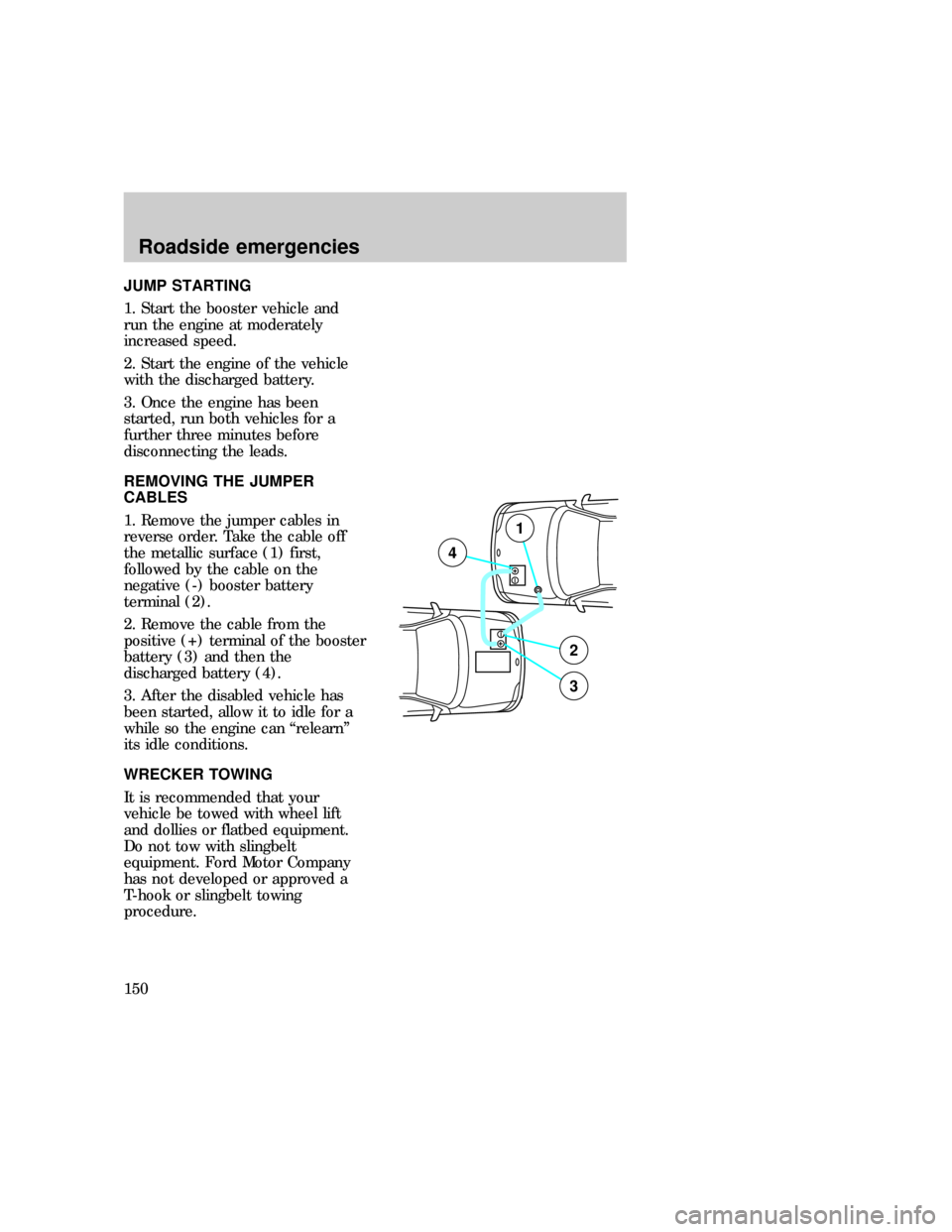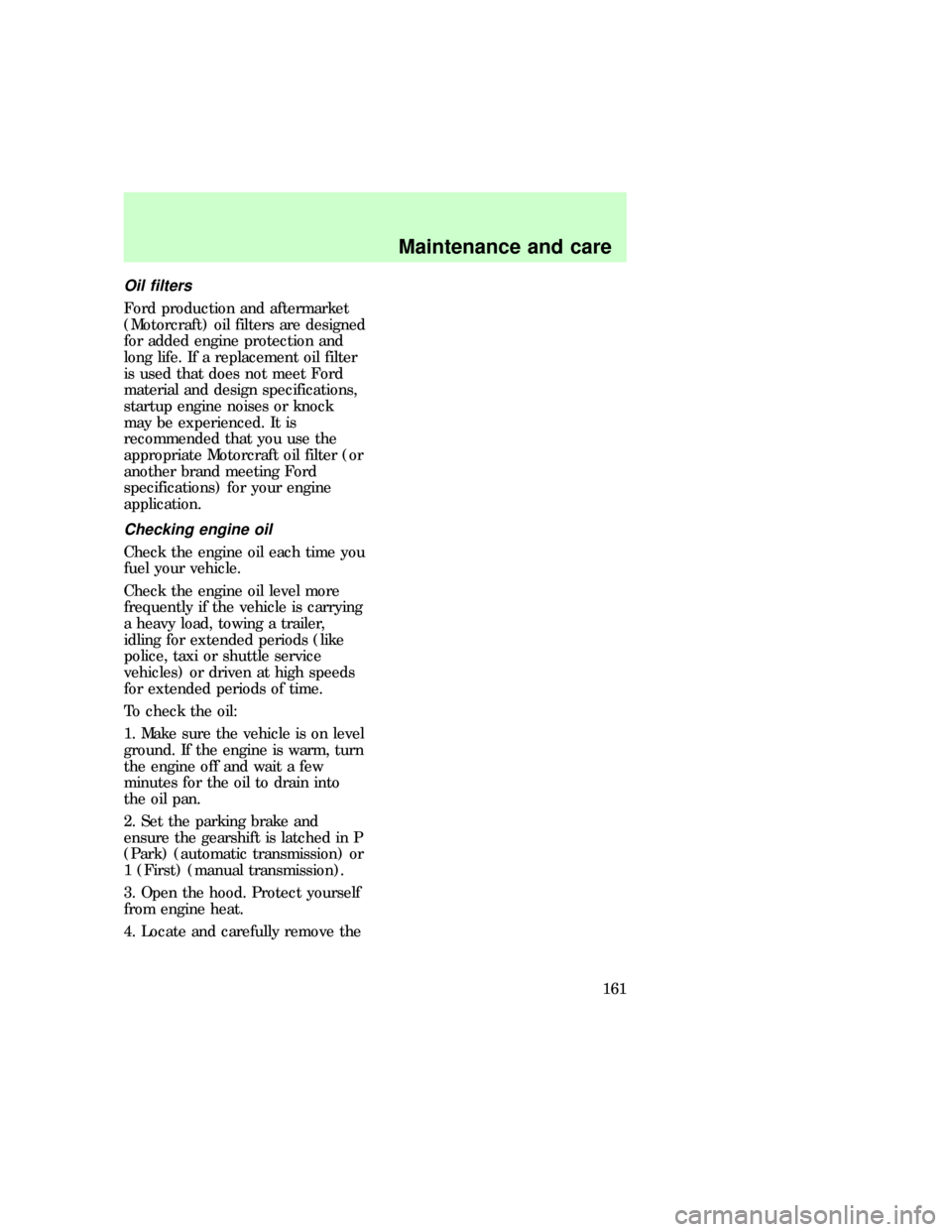Page 139 of 219
Fuses
Position Amps Description
7 15 Parking and tail lamps
8 30 Headlamps
9 15 Daytime running lamps and fog lamps
10 25 Auxiliary power point
11 - Not used
12 - Not used
13 - Not used
14 60/20 4WABS/rear anti-lock brake
15 50 Air suspension compressor
16 40 Trailer tow battery charge and stop/turn lamps
17 30 4WD transfer case shift motor and clutch
18 30 Driver power seat
19 20 Fuel pump
20 50 Instrument panel fuse panel ignition switch feed
21 50 Instrument panel fuse panel ignition switch feed
22 50 I/P fuse panel battery feed
23 40 I/P blower
24 30 PCM power
25 30 Power windows
26 - Not used
27 - Not used
28 30 Trailer tow electronic brake
29 - Not used
Diodes
Position Description
1 Rear ABS diode
2 PCM diode
Roadside emergencies
140
Page 141 of 219
Engine minifuse panel
The minifuse panel is located
behind the power distribution box.
Location Amperage Description
1 5 Powertrain control module (PCM)
2 20 Trailer tow stop/turn lamps
3 - Not used
4 - Not used
5 - Not used
6 - Not used
CHANGING FLAT TIRES
If you get a flat tire while driving,
do not apply the brakes heavily.
Instead, gradually reduce the
speed while holding the steering
wheel firmly. Move the vehicle to a
safe spot off to the side of the
road.
123456
f12_minifuses
f12_flat_tires
f12_change_proc
Roadside emergencies
142
Page 142 of 219
Tire change procedure
1. Park on a level surface.
2. Activate the hazard flashers.
3. Set the parking brake.
4. Place the gearshift in P (Park)
(automatic transmission) or R
(Reverse) (manual transmission).
For 4WD vehicles equipped with
Lever-operated transfer case, make
sure that the lever is not in the N
(Neutral) position.
5. Block the diagonally opposite
wheel.
6. Remove the jack and lug wrench
from under the passenger seat.
On vehicles equipped with
Air Suspension, turn OFF
the Air Suspension switch prior
to jacking, hoisting or towing
your vehicle.
To avoid injury, never run
the engine with one wheel
off the ground, such as when
changing a tire.
f12_removing_spare
Roadside emergencies
143
Page 147 of 219
9. To stow the flat tire, lay the tire
on the ground with the inboard
side facing up. Install the retainer
through the wheel center and slide
the wheel under the vehicle. Turn
the spare handle clockwise until
the tire is raised to its original
position underneath the vehicle.
The spare handle ratchets when
the tire is raised to the stowed
position. It will not allow you to
overtighten.
10. Unblock the wheel.
11. Stow the jacking equipment
under the passenger seat and stow
the jack handle in the engine
compartment.
12. As soon as possible, tighten the
wheel nuts with a torque wrench
to 115±165 Nm (85±115 lb-ft).
JUMP STARTING YOUR
VEHICLE
The gases around the
battery can explode if
exposed to flames, sparks, or lit
cigarettes. An explosion could
result in injury or vehicle
damage.
Do not push-start your
vehicle. You could damage
the catalytic converter. For
further information, seeJumper
Cablesin the Index.
com_jump-starting.01
Roadside emergencies
148
Page 149 of 219

JUMP STARTING
1. Start the booster vehicle and
run the engine at moderately
increased speed.
2. Start the engine of the vehicle
with the discharged battery.
3. Once the engine has been
started, run both vehicles for a
further three minutes before
disconnecting the leads.
REMOVING THE JUMPER
CABLES
1. Remove the jumper cables in
reverse order. Take the cable off
the metallic surface (1) first,
followed by the cable on the
negative (-) booster battery
terminal (2).
2. Remove the cable from the
positive (+) terminal of the booster
battery (3) and then the
discharged battery (4).
3. After the disabled vehicle has
been started, allow it to idle for a
while so the engine can ªrelearnº
its idle conditions.
WRECKER TOWING
It is recommended that your
vehicle be towed with wheel lift
and dollies or flatbed equipment.
Do not tow with slingbelt
equipment. Ford Motor Company
has not developed or approved a
T-hook or slingbelt towing
procedure.
+–
+–
2
3
4
1
com_removing_cables.01
f12_wrecker
Roadside emergencies
150
Page 150 of 219
Ford recommends using one of the
above methods for towing.
Recreational towing (all wheels
on the ground)
Follow these guidelines for your
specific powertrain combination to
tow your vehicle with all four
wheels on the ground (such as
behind a recreational vehicle).
These guidelines are designed to
ensure that your transmission is
not damaged due to insufficient
lubrication.
2WD (manual and automatic
transmissions)
1. Place transmission in N
(Neutral).
f12_recreational_towing
Roadside emergencies
151
Page 160 of 219

Oil filters
Ford production and aftermarket
(Motorcraft) oil filters are designed
for added engine protection and
long life. If a replacement oil filter
is used that does not meet Ford
material and design specifications,
startup engine noises or knock
may be experienced. It is
recommended that you use the
appropriate Motorcraft oil filter (or
another brand meeting Ford
specifications) for your engine
application.
Checking engine oil
Check the engine oil each time you
fuel your vehicle.
Check the engine oil level more
frequently if the vehicle is carrying
a heavy load, towing a trailer,
idling for extended periods (like
police, taxi or shuttle service
vehicles) or driven at high speeds
for extended periods of time.
To check the oil:
1. Make sure the vehicle is on level
ground. If the engine is warm, turn
the engine off and wait a few
minutes for the oil to drain into
the oil pan.
2. Set the parking brake and
ensure the gearshift is latched in P
(Park) (automatic transmission) or
1 (First) (manual transmission).
3. Open the hood. Protect yourself
from engine heat.
4. Locate and carefully remove the
f12_checking_oil
Maintenance and care
161
Page 209 of 219
plastic parts with thinners,
solvents or petroleum-based
cleaners.
Cleaning the exterior lamps
Wash the exterior lamps with the
same detergent you used to wash
the exterior of your vehicle. Use
glass cleaner or tar remover if
necessary.
To avoid scratching the lamps, do
not use a dry paper towel,
chemical solvents or abrasive
cleaners to clean the lamps.
Cleaning the wiper blades
If the wiper blades do not wipe
properly, clean both the windshield
and wiper blades using undiluted
windshield wiper solution or a mild
detergent. Rinse thoroughly with
clean water. To avoid damaging the
blades, do not use fuel, kerosene,
paint thinner or other solvents.
com_exterior_lamps.01
com_wiper_cleaning.01
com_instru-panel_cleaning.01
Maintenance and care
210